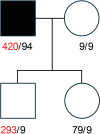Spinocerebellar ataxia 27B (SCA27B)-a systematic review and a case report of a Polish family
- PMID: 40299270
- PMCID: PMC12605495
- DOI: 10.1007/s13353-025-00967-3
Spinocerebellar ataxia 27B (SCA27B)-a systematic review and a case report of a Polish family
Abstract
Dominantly inherited GAA repeat expansions in the FGF14 gene have recently been identified as the cause of spinocerebellar ataxia 27B (SCA27B). Our study focused on a Polish patient case along with asymptomatic family members. Moreover, we systematically reviewed available case reports to better understand the SCA27B phenotype. Genetic tests for SCA27B were performed on genomic DNA isolated from blood. Long-range polymerase chain reaction (LR-PCR) followed by Nanopore sequencing was conducted to establish the number of GAA repeats. The available literature was systematically reviewed per the recommendations of the Preferred Reporting Items for Systematic Reviews and Meta-analyses. The patient's genetic studies identified pure expansions of (GAA) 420/94 repeats in FGF14, confirming the SCA27B diagnosis. A systematic review of 815 cases provides further insight into the typical clinical presentation, with gait ataxia (95.96%) being the most prevalent symptom, followed by abnormal saccadic pursuits (80.69%), nystagmus (71.15%), diplopia (54.05%), and dysarthria (51.22%). Notably, 41.87% of cases exhibited episodic symptoms. The correlation between GAA repeat expansions and the pathogenesis of SCA27B requires further studies. The unique course of the disease with episodic symptoms may cause diagnostic difficulties. Due to its high prevalence in the European population, SCA27B should be considered when diagnosing the causes of late-onset cerebellar ataxia.
Keywords: FGF14; Downbeat nystagmus; GAA repeats; LOCA; SCA27B.
© 2025. The Author(s).
Conflict of interest statement
Declarations. Ethics approval: The research experiment received the approval of the Bioethics Committee at the Karol Marcinkowski Medical University in Poznań No. 798/24. Informed consent was obtained from all individual participants included in the study. Conflicts of interest: The authors declare no conflict of interest in relation to this manuscript.
Figures


References
Publication types
MeSH terms
Substances
LinkOut - more resources
Full Text Sources
Miscellaneous

